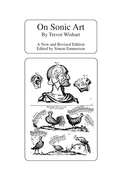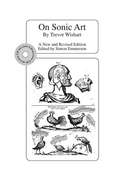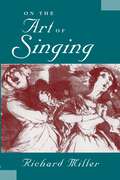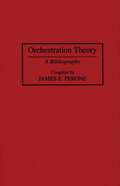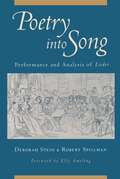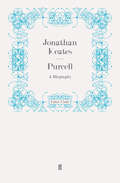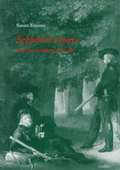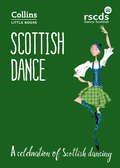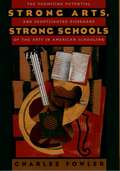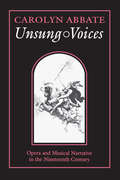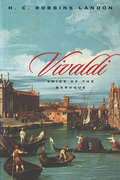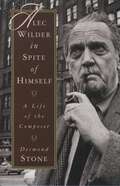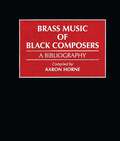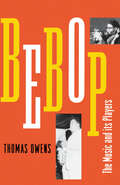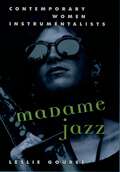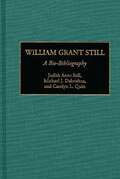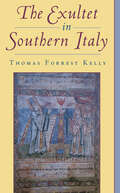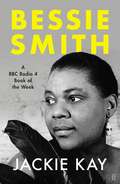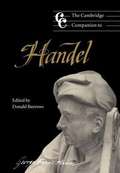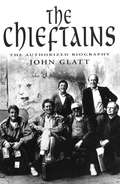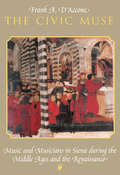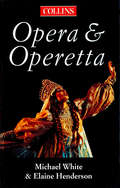- Table View
- List View
On Sonic Art (Contemporary Music Studies #Vol. 12.)
by Trevor WishartIn this newly revised book On Sonic Art, Trevor Wishart takes a wide-ranging look at the new developments in music-making and musical aesthetics made possible by the advent of the computer and digital information processing. His emphasis is on musical rather than technical matters. Beginning with a critical analysis of the assumptions underlying the Western musical tradition and the traditional acoustic theories of Pythagoras and Helmholtz, he goes on to look in detail at such topics as the musical organization of complex sound-objects, using and manipulating representational sounds and the various dimensions of human and non-human utterance. In so doing, he seeks to learn lessons from areas (poetry and sound-poetry, film, sound effects and animal communication) not traditionally associated with the field of music.
On Sonic Art (Contemporary Music Studies #Vol. 12.)
by Trevor Wishart Simon EmmersonIn this newly revised book 'On Sonic Art', Trevor Wishart takes a wide-ranging look at the new developments in music-making and musical aesthetics made possible by the advent of the computer and digital information processing. His emphasis is on musical rather than technical matters. Beginning with a critical analysis of the assumptions underlying the Western musical tradition and the traditional acoustic theories of Pythagoras and Helmholtz, he goes on to look in detail at such topics as the musical organization of complex sound-objects, using and manipulating representational sounds and the various dimensions of human and non-human utterance. In so doing, he seeks to learn lessons from areas (poetry and sound-poetry, film, sound effects and animal communication) not traditionally associated with the field of music.
On the Art of Singing
by Richard MillerThis engaging and long influential collection of essays looks at the art of singing in its totality. Written in a lively, non-technical style, On the Art of Singing is a comprehensive manual that deals with all aspects of singing, from the physiology and acoustics of the singing voice to career-building. Divided into four main sections -- vocal technique, style and interpretation, professional preparation, and vocal pedagogy - the book's structure is such that the reader may pick and choose as personal interests and needs dictate. Containing essential information for all singers, including original research on the mechanics of the voice, this book collects in one volume everything that renowned instructor and singer Richard Miller considers essential to the art of vocal performance. To anyone seeking that elusive state of vocal freedom, whether as a singer or instructor of singers, and to anyone else interested in voice, vocal technique or vocal performance, On the Art of Singing will prove an indispensible guide.
Orchestration Theory: A Bibliography (Music Reference Collection)
by James E. PeronePresenting detailed bibliographic information on all aspects of orchestration, instrumentation, and musical arranging with the broadest possible historical and stylistic palette, this work includes over 1,200 citations. The sources range from treatises, dissertations, and textbooks to journal articles and are cross-referenced and indexed. This is the only comprehensive bibliographic reference guide of its kind on the subject of orchestration. It will be of value to the music theory teacher, undergraduate and graduate students of orchestration, and the researcher.The book contains chapters devoted to book-length treatises; a general bibliography of journal articles and books partially related to orchestration; a chronological list of orchestration treatises; a list of jazz-arranging treatises; a list of band-related treatises; a list of treatises dealing with specific instruments or instrumental families; and an index. This is the first in a series of music theory reference books the author is developing.
Poetry into Song: Performance and Analysis of Lieder
by Deborah Stein Robert SpillmanFocusing on the music of the great song composers--Schubert, Schumann, Brahms, Wolf, and Strauss--Poetry Into Song offers a systematic introduction to the performance and analysis of Lieder . Part I, "The Language of Poetry," provides chapters on the themes and imagery of German Romanticism and the methods of analysis for German Romantic poetry. Part II, "The Language of the Performer," deals with issues of concern to performers: texture, temporality, articulation, and interpretation of notation and unusual rhythm accents and stresses. Part III provides clearly defined analytical procedures for each of four main chapters on harmony and tonality, melody and motive, rhythm and meter, and form. The concluding chapter compares different settings of the same text, and the volume ends with several appendices that offer text translations, over 40 pages of less accessible song scores, a glossary of technical terms, and a substantial bibliography. Directed toward students in both voice and theory, and toward all singers, the authors establish a framework for the analysis of song based on a process of performing, listening, and analyzing, designed to give the reader a new understanding of the reciprocal interaction between performance and analysis. Emphasizing the masterworks, the book features numerous poetic texts, as well as a core repertory of songs. Examples throughout the text demonstrate points, while end of chapter questions reinforce concepts and provide opportunities for directed analysis. While there are a variety of books on Lieder and on German Romantic poetry, none combines performance, musical analysis, textual analysis, and the interrelation between poetry and music in the systematic, thorough way of Poetry Into Song.
Purcell: A Biography
by Jonathan KeatesIn the chaos of the English Civil War and Puritan Commonwealth, churches were defaced and organs broken, but the tradition of fine music survived. When Charles II returned from exile in 1660, one of the first things he demanded was music, sacred and profane, anthems and motets, pavannes and gavottes. In 1659 Henry Purcell was born, and his genius would give the period and nation an unforgettable voice.Jonathan Keates traces Purcell's development against the turbulent movements of his time - political, religious, theatrical and social. He shows him growing up in the shadow of Westminster Abbey and follows him as a chorister in the Chapel Royal, copying the innovative and colourful style of Matthew Locke; beginning to composer for the theatre, and for State occasions; writing his great settings of sacred music, his chamber sonatas, and his triumphant Dido and Aeneas, the first British opera.In the background are the heady politics of Restoration England, which expelled the Stuart James II and brought William and Mary to the throne. But almost more important is the rich musical history, the influence of French and Italian composers, blending with and modifying the native tradition. We know and love Purcell through his work; his songs were sung in taverns, his psalms in churches; he was urbane and witty, impassioned and profound.This engrossing biography is as remarkable for its sensitive critical appreciation of Purcell's music, in all its forms, as it is for its vivid portrait of the man, and the boisterous age in which he lived.
Schubert's Poets and the Making of Lieder (PDF)
by Susan YouensLieder began with words, with the composer's discovery of a poet and a poetic work, but the scholarly study of lieder has tended to bypass those origins. Schubert's choice of poets has traditionally come under fire for the preponderance of mediocre talent, and yet many of these writers were highly esteemed in their day. In her highly acclaimed study, Susan Youens has chosen four such poets - Gabriele von Baumberg, Theodor Körner, Johann Mayrhofer and Ernst Schulze - in order to re-examine their lives, works, and Schubert's music to their verse. All four poets were vivid inhabitants of a vivid era, and their tribulations afford us added insight into the upheavals, the manners and mores, of their day.
Scottish Dance: A celebration of Scottish dancing (Collins Little Books)
by The Royal Scottish Country Dance SocietyA perfect introduction to the world of Scottish dance written by the Royal Scottish Country Dance Society, including a short history of Scottish dancing. The book takes you through simple ceilidh moves to more complex formations and set dances, illustrated through diagrams and photos.
Strong Arts, Strong Schools: The Promising Potential and Shortsighted Disregard of the Arts in American Schooling
by the late Charles FowlerIn this elegantly written, passionately argued book, Fowler presents a convincing case for teaching the arts to all children. He argues that, far from a luxury, the arts are a vitally important part of our society and our schools. Highlighting the crucial effect of the arts on learning, this volume shows how the arts can enliven and extend the entire school curriculum by integrating different subjects in innovative interdisciplinary ways. These eighteen compelling essays are a clarion call to action for any teacher, parent, policy maker, or citizen concerned about the fate of the arts in American society and schools.
Unsung Voices: Opera and Musical Narrative in the Nineteenth Century
by Carolyn AbbateWho "speaks" to us in The Sorcerer's Apprentice, in Wagner's operas, in a Mahler symphony? In asking this question, Carolyn Abbate opens nineteenth-century operas and instrumental works to new interpretations as she explores the voices projected by music. The nineteenth-century metaphor of music that "sings" is thus reanimated in a new context, and Abbate proposes interpretive strategies that "de-center" music criticism, that seek the polyphony and dialogism of music, and that celebrate musical gestures often marginalized by conventional music analysis.
Vivaldi: Voice of the Baroque
by H. C. LandonVivaldi boasted that he could compose a concerto faster than a scribe could copy one. Despite his prolificacy, The Four Seasons, and the majority of his already published work had fallen into obscurity by the time of his death in poverty in 1741. Most of his music-concertos, sonatas, operas, and sacral music-has been published only recently. Very little has been written on Vivaldi for the nonspecialist, especially in English. Landon rediscovers the composer in this accessible and musically informed biography while presenting documentation of the musician's life discovered after the Baroque revival in the 1930s. This book includes illustrations of eighteenth-century Venice and several newly translated letters, thoroughly evoking the style of the time and revealing some of the more personal aspects of Vivaldi's life. "Belongs on the shelf of every serious music student."—Kirkus "Gives a good feel for Vivaldi's life and times . . . and describes particularly well how Vivaldi has been revived."—Booklist "Robbins Landon is marvelously entertaining, extravagantly learned."—The Independent
Poetry into Song: Performance and Analysis of Lieder
by Deborah Stein Robert SpillmanFocusing on the music of the great song composers--Schubert, Schumann, Brahms, Wolf, and Strauss--Poetry Into Song offers a systematic introduction to the performance and analysis of Lieder . Part I, "The Language of Poetry," provides chapters on the themes and imagery of German Romanticism and the methods of analysis for German Romantic poetry. Part II, "The Language of the Performer," deals with issues of concern to performers: texture, temporality, articulation, and interpretation of notation and unusual rhythm accents and stresses. Part III provides clearly defined analytical procedures for each of four main chapters on harmony and tonality, melody and motive, rhythm and meter, and form. The concluding chapter compares different settings of the same text, and the volume ends with several appendices that offer text translations, over 40 pages of less accessible song scores, a glossary of technical terms, and a substantial bibliography. Directed toward students in both voice and theory, and toward all singers, the authors establish a framework for the analysis of song based on a process of performing, listening, and analyzing, designed to give the reader a new understanding of the reciprocal interaction between performance and analysis. Emphasizing the masterworks, the book features numerous poetic texts, as well as a core repertory of songs. Examples throughout the text demonstrate points, while end of chapter questions reinforce concepts and provide opportunities for directed analysis. While there are a variety of books on Lieder and on German Romantic poetry, none combines performance, musical analysis, textual analysis, and the interrelation between poetry and music in the systematic, thorough way of Poetry Into Song.
Alec Wilder in Spite of Himself: A Life of the Composer
by Desmond StoneAlec Wilder wrote songs and lyrics of unsurpassed beauty and originality, and his work won the respect and admiration of such important musical figures as Frank Sinatra, Peggy Lee, Mitch Miller, Gunther Schuller, and many others. Yet Wilder seemed almost to court obscurity. Both in the music he composed and in the way he lived his life, Wilder valued the unique and eccentric over the established and easily acceptable. And though he authored the definitive American Popular Song--which critics praised as "singular" (Studs Terkel), "pioneering" (Whitney Balliett), "rewarding" (Milton Babbitt), and "a joy to anyone who really cares about American popular music" (Max Morath)--his own contribution to that music has remained, until now, too little known and far too little appreciated. Desmond Stone's engaging and lively biography brings Alec Wilder's life and music into the spotlight where it belongs. Ranging from Wilder's childhood in Rochester, New York, to his rise as a major writer of popular songs in the 1940s, to his relationships with Frank Sinatra and the cabaret singer Mabel Mercer, Stone gives us rich insight into the creative process and profound influence of this highly unorthodox composer. We see the impulses and musical concerns that led to such standards as "I'll Be Around" and "It's So Peaceful in the Country." We also get an inside view of how he wrote his monumental American Popular Song, which remains the most significant study of America's great songwriters. More important, we get a vivid sense of a haunting, incorruptible melodist whose unique personality was mirrored in his music. Man and composer dared to be different. When Wilder in the late 1930s wrote his famous Octets, the music world did not know what to make of these irreverent, highly original pieces. Yet they had a seminal influence on jazz chamber music in America. Wilder would go on to compose hundreds of instrumental numbers. Whether he was writing concert pieces for an unprecedented and highly unusual group of instruments, or mixing jazz, classical, and popular idioms in a single song, or dashing off a sonata for a friend, Wilder followed the dictates of his own creativity rather than the expectations of the musical establishment. Such independence and unpredictability earned him the hostility of many critics but the enduring respect of the musicians he wrote for. Here then is a fascinating private portrait of a man who lived a nomad's life, who loved riding trains so much he kept a timetable in his pocket at all times, a man whose only home was a small room he maintained at the Algonquin Hotel in Manhattan (where he often held court in the lobby), a man with a serious drinking problem as well as the kindest and most generous of friends. Essential reading for anyone interested in American popular music, Alec Wilder in Spite of Himself provides a much needed account of this complex, colorful, and highly original life.
Brass Music of Black Composers: A Bibliography (Music Reference Collection)
by Aaron HorneAaron Horne provides the most comprehensive guide to brass music written by black composers. He covers composers from around the world in the 19th and 20th centuries. Included in the book is biographical information; commission, duration, instrumentation, date of publication, premiere, publisher, discography for each piece; bibliographical sources; and an index which groups the music by numbers, medium, and ensemble.This is the fourth volume in Aaron Horne's monumental effort to provide the most comprehensive guide to music composed by black composers. In this volume he covers composers from around the world in the 19th and 20th centuries, including William Grant Still, Ulysses Kay, Anthony Davis, John Coltrane, and other major figures from the world of classical, jazz, and popular music.The main body of the book is divided into sections devoted to African, African American, Afro-European, and Afro-Latino composers. Within each section composers are arranged alphabetically; each entry provides biographical information as well as commission, duration, instrumentation, date of publication, premiere, publisher, discography for each composition. Backmatter includes a Brass Music Index which groups the music by numbers, medium, and ensembles; a title index; discography; and bibliography. As with the earlier volumes, this is an essential reference tool for anyone with an interest in researching and/or performing the music of black composers.
Bebop: The Music and Its Players
by Thomas Owens"When bebop was new," writes Thomas Owens, "many jazz musicians and most of the jazz audience heard it as radical, chaotic, bewildering music." For a nation swinging to the smoothly orchestrated sounds of the big bands, this revolutionary movement of the 1940s must have seemed destined for a short life on the musical fringe. But today, Owens writes, bebop is nothing less than "the lingua franca of jazz, serving as the principal musical language of thousands of jazz musicians." In Bebop, Owens conducts us on an insightful, loving tour through the music, players, and recordings that changed American culture. Combining vivid portraits of bebop's gigantic personalities with deft musical analysis, he ranges from the early classics of modern jazz (starting with the 1943 Onyx Club performances of Dizzy Gillespie, Max Roach, Oscar Pettiford, Don Byas, and George Wallington) through the central role of Charlie Parker, to an instrument-by-instrument look at the key players and their innovations. Illustrating his discussion with numerous musical excerpts, Owens skillfully demonstrates why bebop was so revolutionary, with fascinating glimpses of the tempestuous jazz world: Thelonious Monk, for example, did "everything 'wrong' in the sense of traditional piano technique....Because his right elbow fanned outward away from his body, he often hit the keys at an angle rather than in parallel. Sometimes he hit a single key with more than one finger, and divided single-line melodies between two hands." In addition to his discussions of individual instruments and players, Owens examines ensembles, with their sometimes volatile collaborations: in the Jazz Messengers, Benny Golson told of how his own mellow saxophone playing would get lost under Art Blakey's furious drumming: "He would do one of those famous four-bar drum rolls going into the next chorus, and I would completely disappear. He would holler over at me, 'Get up out of that hole!'" In this marvelous account, Owens comes right to the present day, with accounts of new musicians ranging from the Marsalis brothers to lesser-known masters like pianist Michel Petrucciani. Bebop is a jazz-lover's dream--a serious yet highly personal look at America's most distinctive music.
Madame Jazz: Contemporary Women Instrumentalists
by Leslie GourseNadine Jansen, a flugelhornist and pianist, remembers a night in the 1940s when a man came out of the audience as she was playing both instruments. "I hate to see a woman do that," he explained as he hit the end of her horn, nearly chipping her tooth. Half a century later, a big band named Diva made its debut in New York on March 30, 1993, with Melissa Slocum on bass, Sue Terry on alto sax, Lolly Bienenfeld on trombone, Sherrie Maricle on drums, and a host of other first rate instrumentalists. The band made such a good impression that it was immediately booked to play at Carnegie Hall the following year. For those who had yet to notice, Diva signaled the emergence of women musicians as a significant force in jazz. Madame Jazz is a fascinating invitation to the inside world of women in jazz. Ranging primarily from the late 1970s to today's vanguard of performance jazz in New York City and on the West Coast, it chronicles a crucial time of transition as women make the leap from novelty acts regarded as second class citizens to sought-out professionals admired and hired for their consummate musicianship. Author Leslie Gourse surveys the scene in the jazz clubs, the concert halls, the festivals, and the recording studios from the musicians' point of view. She finds exciting progress on all fronts, but also lingering discrimination. The growing success of women instrumentalists has been a long time in coming, she writes. Long after women became accepted as writers and, to a lesser extent, as visual artists, women in music--classical, pop, or jazz--faced the nearly insuperable barrier of chauvinism and the still insidious force of tradition and habit that keeps most men performing with the musicians they have always worked with, other men. Gourse provides dozens of captivating no-holds-barred interviews with both rising stars and seasoned veterans. Here are up-and-coming pianists Renee Rosnes and Rachel Z., trumpeter Rebecca Coupe Frank, saxophonist Virginia Mayhew, bassist Tracy Wormworth, and drummer Terri Lynne Carrington, and enduring legends Dorothy Donegan, Marian McParland and Shirley Horne. Here, as well, are conversations with three pioneering business women: agent and producer Helen Keane, manager Linda Goldstein, and festival and concert producer Cobi Narita. All of the women speak insightfully about their inspiration and their commitment to pursuing the music they love. They are also frank about the realities of life on the road, and the extra dues women musicians pay in a tough and competitive field where everybody pays dues. A separate chapter offers a closer look at women musicians and the continual stress confronting those who would combine love, marriage, and/or motherhood with a life in music. Madame Jazz is about the history that women jazz instrumentalists are making now, as well as an inspiring preview of the even brighter days ahead. It concludes with Frankie Nemko's lively evaluation of the West Coast jazz scene, and appends the most comprehensive list ever assembled of women currently playing instruments professionally.
On the Art of Singing
by Richard MillerThis engaging and long influential collection of essays looks at the art of singing in its totality. Written in a lively, non-technical style, On the Art of Singing is a comprehensive manual that deals with all aspects of singing, from the physiology and acoustics of the singing voice to career-building. Divided into four main sections -- vocal technique, style and interpretation, professional preparation, and vocal pedagogy - the book's structure is such that the reader may pick and choose as personal interests and needs dictate. Containing essential information for all singers, including original research on the mechanics of the voice, this book collects in one volume everything that renowned instructor and singer Richard Miller considers essential to the art of vocal performance. To anyone seeking that elusive state of vocal freedom, whether as a singer or instructor of singers, and to anyone else interested in voice, vocal technique or vocal performance, On the Art of Singing will prove an indispensible guide.
William Grant Still: A Bio-Bibliography (Bio-Bibliographies in Music)
by Michael J. Dabrishus Carolyn Quin Judith A. StillPresenting the life and professional career of The Dean of Afro-American Composers, this is the first comprehensive book on the writings by and about Still, the compositions with manuscript sources, the performances of Still's works, and the reviews of those performances. It includes a touching personal reminiscence by his daughter Judith Anne. The full resources of the extensive collection known as The William Grant Still and Verna Arvey Papers at the University of Arkansas Libraries, Fayetteville, give this book the distinction of being the first one about Still that utilizes diaries, letters, scrapbooks, and family papers to provide information on his works and performances.Still performed, composed, and arranged in the commercial music field before he began to write orchestral works and opera. He is called the Dean of Afro-American Composers because of his pioneering efforts on behalf of American music and his achievements as an African American. Still was the first African American to write a symphony that was performed by a major symphony orchestra in the United States, the first to conduct a major symphony orchestra, the first to conduct a major symphony in the Deep South, the first to direct a white radio orchestra, the first to have an opera produced by a major company, and the first to have an opera televised over a national network. His career tells an important story about the development of an American style of music.
The Exultet in Southern Italy
by Thomas Forrest KellyThe Exultet rolls of southern Italy are parchment scrolls containing text and music for the blessing of the great Easter candle; they contain magnificent illustrations, often turned upside down with respect to the text, The Exultet in Southern Italy provides a broad perspective on this phenomenon that has long attracted the interest of those interested in medieval art, liturgy, and music. This book considers these documents in the cultural and liturgical context in which they were made, and provides a perspective on all aspects of this particularly southern Italian practice. While previous studies have concentrated on the illustrations in these rolls, Kelly's book also looks at the particular place of the Exultet in changing ceremonial practices, provides background on the texts and music used in southern Italy, and inquires into the manufacture and purpose of the Exultets--why they were made, who owned them, and how they were used.
Strong Arts, Strong Schools: The Promising Potential and Shortsighted Disregard of the Arts in American Schooling
by the late Charles FowlerIn this elegantly written, passionately argued book, Fowler presents a convincing case for teaching the arts to all children. He argues that, far from a luxury, the arts are a vitally important part of our society and our schools. Highlighting the crucial effect of the arts on learning, this volume shows how the arts can enliven and extend the entire school curriculum by integrating different subjects in innovative interdisciplinary ways. These eighteen compelling essays are a clarion call to action for any teacher, parent, policy maker, or citizen concerned about the fate of the arts in American society and schools.
Bessie Smith: A RADIO 4 BOOK OF THE WEEK (Outlines Ser.)
by Jackie KayA BBC RADIO 4 BOOK OF THE WEEKBessie Smith: singer, icon, pioneer.Scotland's National Poet Jackie Kay brings to life the tempestuous story of the greatest blues singer who ever lived. 'A wonderful writer on a magnificent singer.' ROBERT WYATT'The most vivid evocation of Bessie Smith I have ever read.' IAN CARR, BBC MUSIC 'Biographies don't usually bring the subject to life again. This one did. I finished the book then started it again immediately.' PEGGY SEEGER'What a life! What gulpable storytelling! Exactly the kind of writing about music we need: personal, ardent, playfully confrontational, questioning, undogmatic. A love song to a complicated idol' KATE MOLLESON'Pure joy: one trailblazing woman pays tribute to another. Jackie Kay finds the music in the short, dazzling, capricious life of Bessie Smith'HELEN LEWIS'A passionate, personal, imaginative insight into Bessie's art.' DAILY MAIL***BESSIE SMITH was born in Tennessee in 1894. Orphaned by the age of nine, she sang on street corners before becoming a big name in travelling shows. In 1923 she made her first recording for a new start-up called Columbia Records. It sold 780,000 copies and made her a star. Smith's life was notoriously difficult: she drank pints of 'bathtub gin', got into violent fist fights, spent huge sums of money and had passionate love affairs with men and women. She once single-handedly fought off a cohort of the Ku Klux Klan.As a young black girl growing up in Glasgow, Jackie Kay found in Bessie someone with whom she could identify and who she could idolise. In this remarkable book Kay mixes biography, fiction, poetry and prose to create an enthralling account of an extraordinary life.
The Cambridge Companion To Handel (PDF)
by Donald Burrows Jonathan CrossHandel is recognised as one of the principal creative figures in Baroque music. In this Companion acknowledged experts on Handel make their expertise accessible to the interested general reader and music lover. All the genres in which Handel composed are considered including oratorio, chamber cantata, opera, and church music, as well as works for the keyboard and orchestra. The wide-ranging, specially-commissioned essays cover topics from Handel's composing methods to his treatment of the Italian language and matters of performance practice. The background to Handel's musical career is a major theme of the volume. The opening chapters deal with his musical education in Germany and the circumstances in Italy during his time there. Most of Handel's career was based in London and important topics here include contemporary concert life and theatre management, the British and Italian musicians among whom he worked, and the librettists for the English oratorios.
The Chieftains: The Authorised Biography
by John GlattThe Chieftains have become international superstars as well as being an institution in Folk Music. They have performed and recorded with such stars such as Bob Dylan, Van Morrison, The Rolling Stones, Mark Knopfler. . . . and others. This authorised biography will trace the history of the band and its members from its small beginnings in Ireland in the early 1960s to their current status, and will feature exclusive interviews with all the members of the band and many of their friends and collaborators, along with photographs and other memorabilia from the band's own collection.
The Civic Muse: Music and Musicians in Siena during the Middle Ages and the Renaissance
by Frank A. D'AcconeSiena, blessed with neither the aristocratic nor the ecclesiastical patronage enjoyed by music in other northern Italian centers like Florence, nevertheless attracted first-rate composers and performers from all over Europe. As Frank A. D'Accone shows in this scrupulously documented study, policies developed by the town to favor the common good formed the basis of Siena's ambitious musical programs. Based on decades of research in the town's archives, D'Accone's The Civic Muse brilliantly illuminates both the sacred and the secular aspects of more than three centuries of music and music-making in Siena. After detailing the history of music and liturgy at Siena's famous cathedral and of civic music at the Palazzo Pubblico, D'Accone describes the crucial role that music played in the daily life of the town, from public festivities for foreign dignitaries to private musical instruction. Putting Siena squarely on the Renaissance musical map, D'Accone's monumental study will interest both musicologists and historians of the Italian Renaissance.
The Collins Guide To Opera And Operetta
by Michael White Elaine HendersonOriginally published in 1997, Collins Opera & Operetta is an invaluable guide to this fascinating but sometimes misunderstood art form, presenting essential information on over 180 major operas and operettas in an accessible, yet scholarly, way.
